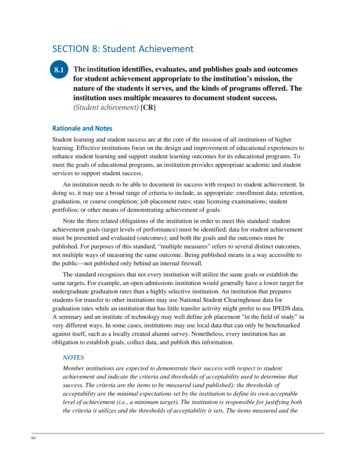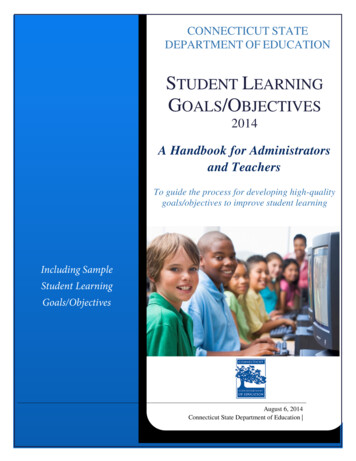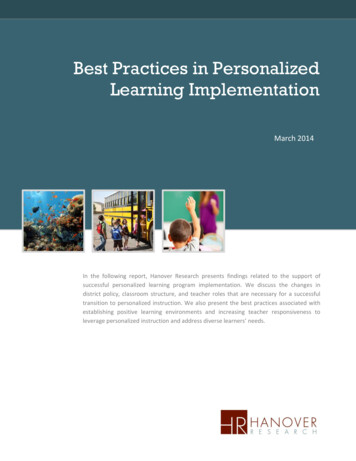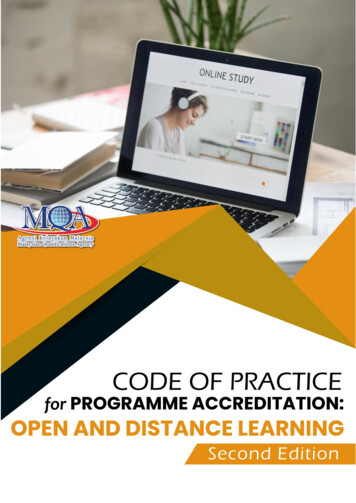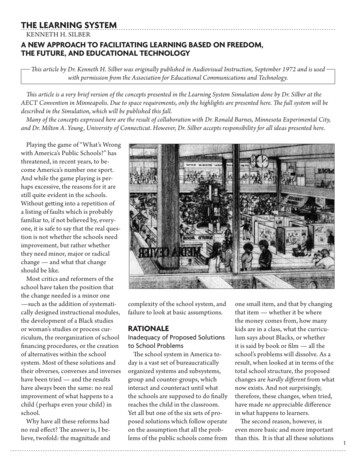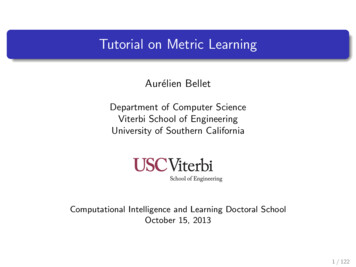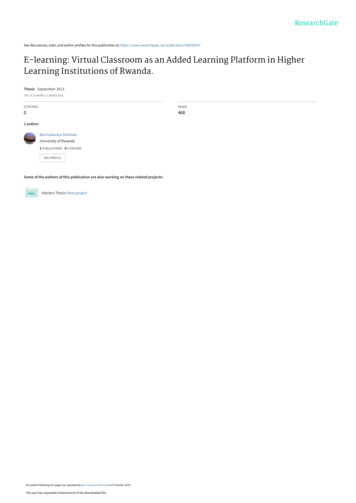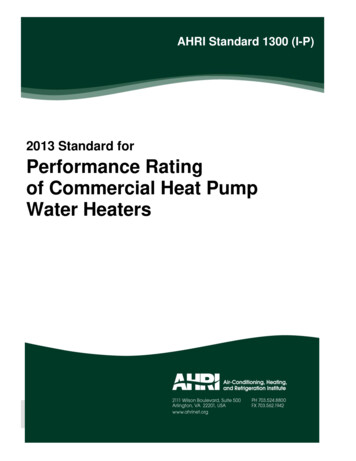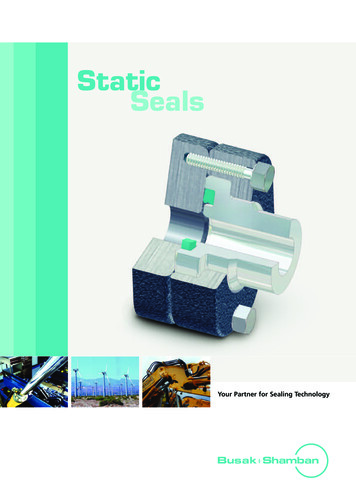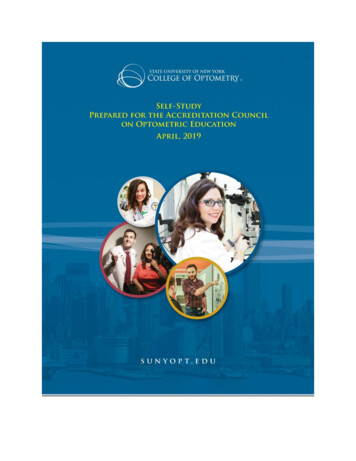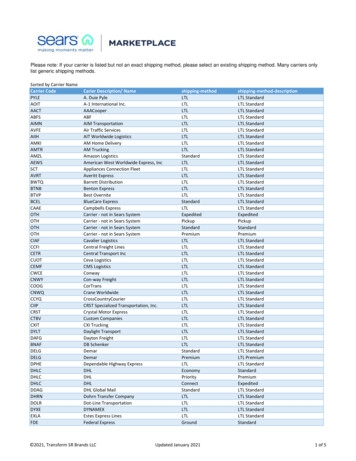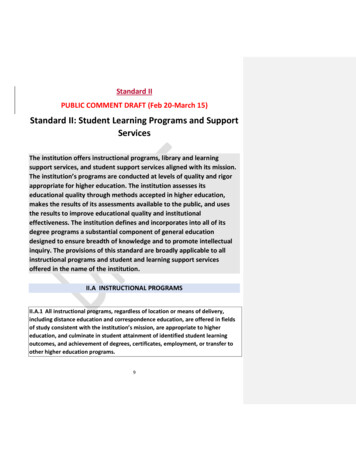
Transcription
Standard IIPUBLIC COMMENT DRAFT (Feb 20-March 15)Standard II: Student Learning Programs and SupportServicesThe institution offers instructional programs, library and learningsupport services, and student support services aligned with its mission.The institution’s programs are conducted at levels of quality and rigorappropriate for higher education. The institution assesses itseducational quality through methods accepted in higher education,makes the results of its assessments available to the public, and usesthe results to improve educational quality and institutionaleffectiveness. The institution defines and incorporates into all of itsdegree programs a substantial component of general educationdesigned to ensure breadth of knowledge and to promote intellectualinquiry. The provisions of this standard are broadly applicable to allinstructional programs and student and learning support servicesoffered in the name of the institution.II.A INSTRUCTIONAL PROGRAMSII.A.1 All instructional programs, regardless of location or means of delivery,including distance education and correspondence education, are offered in fieldsof study consistent with the institution’s mission, are appropriate to highereducation, and culminate in student attainment of identified student learningoutcomes, and achievement of degrees, certificates, employment, or transfer toother higher education programs.9
As noted in our Educational Master Plan, “Our mission, vision and values drive our work at CSM”[II.A.1-1] This includes instructional programs, which are aligned with the College’s mission,appropriate to higher education, and lead to defined student learning outcomes as well asstudent achievement goals.EVIDENCE OF MEETING THE STANDARDAlignment with mission: All instructional programs at CSM, regardless of delivery method orlocation, are consistent with the College’s mission, which focuses on our commitment to servingthe educational needs of our community [II.A.1-2]. The Curriculum Committee requires thatprograms be aligned with the College’s mission [II.A.1-3] and the Board is tasked with approvingprograms to ensure that “program offerings are responsive to and reflect community needs”[II.A.1-4]. In Program Review, in describing their programs, disciplines must explain theiralignment with the College mission [II.A.1-5, 6].To this end, the College fields a variety of offerings [II.A.1-7] Lower division baccalaureate study for transfer (the IGETC and UC/CSU pattern)Associates degrees in academic and career technical fields (CTE)Certificates of Achievement and Specialization, notably in CTE programs, to preparestudents for the workforceBasic and foundational skills.Quality and appropriateness of courses and services to higher education, focused on clearlyidentified learning outcomes: Courses and programs are appropriate to higher education, andculminate in clearly identified learning outcomes.The College maintains the quality of its programs and services, and their relevance to its mission,through a number of systematic review processes, primarily the curriculum approval and reviewprocess.The College uses Curricunet to shepherd new courses and programs through a systematic anddetailed approval process compliant with Title V. Faculty must submit details of catalogdescription, course objectives, student learning outcomes, transferability, GE applicability, andunits, as well as sample methods of instruction, assignments, and suggested texts [II.A.1-8]. Theprograms and courses are reviewed by a Technical Review Committee including discipline experts,relevant administrators, Distance Education specialists and the SLO assessment coordinator[II.A.1-9] before being submitted for consideration by the Curriculum Committee1, which is a subcommittee of the Academic Senate, and composed of faculty from each division, as well as nonvoting administrators [II.A.1-10].1Prior to Fall 2018, this was known as the Committee on Instruction. Its name was officiallychanged by Academic Senate in May 2018.10
Learning outcomes are created as part of the curriculum approval process. In addition, outcomesare aligned to create an educational map: program outcomes are aligned to the outcomes of theirconstituent courses, and institutional outcomes are aligned to course and service outcomes[II.A.1-11]. Faculty regularly review alignments for clarity, currency and coherence, as part ofProgram Review [II.A.1-12, 13].Culmination in student attainment of learning outcomes, and student achievement of degreesor certificates: Most disciplines offer degree and/or certificate programs. Information aboutthese, including the program learning outcomes, required courses, transfer patterns andrecommended high school preparation, is published in the Catalog [II.A.1-14]. In addition, eachdiscipline has its own web pages on the College website, which describes the discipline’s courseofferings, degrees and/or certificates offered, program learning outcomes, and employment andtransfer information [II.A.1-15].Location and delivery method: The College offers a number of courses online through DistanceEducation as well as at some other locations. Regardless of modality or location, courses andprograms are all held to the same standard and follow the same curriculum approval process.A handful of courses are also offered at local high schools as part of the College’s newlydeveloping Dual Enrolment program. Guided by AB 288 (College and Career Access PathwaysCCAP) legislation, Dual Enrolment aims to build more intentional pathways to strengthen thetransition from high school to the College, notably for underrepresented students [II.A.1-16, 17].Some courses are offered for joint high school and college credit, and some for college credit only[II.A.1-18] The College is in the process of developing procedures and policies for the dualenrolment program. However, all instructors teaching a dual or concurrent enrolment coursemust meet Minimum Qualifications, and adhere to the course outline of record. The College isfollowing the guidelines outlined in the Career Ladders Project Dual Enrolment Guide, whichstipulates thatas with any other college course, adherence to the course outline of record is required.Dual enrollment courses introduce students to the rigors and demands of college-levelwork, grant college credit, and ensure that students have the knowledge and skills tocontinue their postsecondary journey [II.A.1-19].In addition, CSM courses are offered at various juvenile detention facilities through aCSM program called Project Change. These courses are offered at the following locations: SanMateo County Juvenile Hall (Youth Services Center), Camp Kemp, and Camp Glenwood. ProjectChange offers the following UC/CSU transferable courses each semester: Psychology 100,Sociology 100, LCTR 105 "Keys to Success." These courses are taught by regular CSM faculty, andfollow the same curriculum and adhere to the same standards as their on-campus counterparts.[II.A.1-20].11
Distance education courses are likewise held to the same standards, and follow the samecurricular approval process. Board policy requires that distance education courses “be approvedunder the same conditions as all other courses” (albeit with a separate, additional review, asmandated by Title V) so that the “same standards of course quality are applied to the distanceeducation courses” as to traditional courses [II.A.1-21]. Hybrid or online courses must alsocomplete a separate Distance Education Supplement [II.A.1-22]. Through the coordinated effortsof faculty (through Program Review), deans, PRIE, and the Integrated Planning Committee,planning for distance education courses is “integrated into CSM’s institutional planning processesand cycles” [II.A.1-23, 24, 25].ANALYSIS AND EVALUATIONCollege of San Mateo meets the standard. Courses and programs, regardless of mode of deliveryor location, go through a curriculum review process that ensures that they reflect the College’sMission and Values statements, meet generally accepted standards for higher education,culminate (at the course and program level) in identified learning outcomes, and lead to degrees,certificates, and transfer to four-year institutions. Students are well-prepared by their work atCSM.In 2017, the College announced a focus on “moving the needle” – that is, improving degree andcertificate attainment [II.A.1-26]. The focus is on improving student performance and learningthrough a more structured, supported overall experience inside and outside the classroom. Tothis end, the College is investing in Guided Pathways [II.A.1-27], and has overhauled itsassessment process to support and sustain an interdisciplinary community of practice (for moreon this, see II.A.3).The College Index provides a summary of data on student outcomes and institutionaleffectiveness [II.A.1-28]. Information in the College Index is updated annually to reflect resultsand establish targets for the following year. The College Index has been used by the InstitutionalPlanning Committee to track the College’s progress in achieving its Strategic Goals on a regularbasis [II.A.1-29, 30, 31, 32, 33]. More recently, the district has introduced a local set of indicatorstied to the District Strategic Plan [II.A.1-35]. IPC reviewed these indicators and established collegetargets [II.A.1-36, 37]. It is anticipated that the resulting Strategic Plan Goals: Metrics, Trends, andTargets summary will replace the College Index, and that the College will continue to use this datato support its mission (as evidenced in a recent Board study session) [II.A.1-38].EVIDENCE LIST FOR II.A.1II.A.1-1Educational Master Plan, “Mission, Vision and Values,” p. 212
II.A.1-2Mission Statement mentsslos/II.A.1-3Curriculum Handbook p. dfII.A.1-4Board Policy 1e, SMCCD, BP 1.10 “Duties and Responsibilities of the oliciesandProcedures/1 10.pdfII.A.1-5Program Review form (question forms/201819 ProgramReview-Instruction.pdfII.A.1-6For example, the History program review Fall id d4f6466c46644a80974c1e53c95431a3&s 7dfd5d861cab40c698ca342141e96fecII.A.1-7Catalog ams/II.A.1-8Details of course creation requirements: Curriculum Handbook, p. fII.A.1-10Details of the Curriculum Committee: Faculty Handbook 2017-2018, p. dbook 2018-19.pdfII.A.1-11Map showing alignment of outcomes Outcomes alignment chartII.A.1-12Program Review form (question forms/201819 ProgramReview-Instruction.pdfII.A.1-13For instance, the English department reviewed their course-to-program spx?doid 45ba972416264f1798060216bec1a8c7&s 7dfd5d861cab40c698ca342141e96fecII.A.1-14For example, see the Accounting degree es.aspII.A.1-15For example, see the Addiction Studies degree page:http://collegeofsanmateo.edu/aods/degrees alcohol aa.asp13Formatted: Highlight
II.A.1-16“Strengthening High School Pathways Through Intentional Career ersonal/brickerl smccd edu/ layouts/15/Doc.aspx?sourcedoc %7B3A676B25-CB0C-4436-8C46F6C81F0938EB%7D&file BOT GuidedPathways CSM%20(002).docx&action default&mobileredirect trueII.A.1-17“Dual-E at CSM” kerl smccd edu/ layouts/15/Doc.aspx?sourcedoc %7B2351a521-04b9-437a-ae133172467f1e19%7D&action edit&uid Id 726&ListId %7BCAAF2BA6-16FD-4FDD-88AAA3CFFBDED6F1%7D&odsp 1&env prodII.A.1-18Dual enrolment course schedule AY m glance 201808.pdf (note coursesoffered at Hillsdale High School)II.A.1-19Career Ladders Project, Dual Enrolment Toolkit – FAQs, p. ject Change 21Board Policy Board Policy 6.12.1, Distance Ed, 3 and 4a, /6 12.1.pdfII.A.1-22Distance Education supplement form / curriculum approval processII.A.1-23Distance Education plan 2017-2020, Goals & ObjectivesII.A.1-24Evidence of distance education integrated into institutional planning discussions:Institutional Planning Committee minutes 2017/2017-0317 IPCMeetingSummary.pdfII.A.1-25Institutional Planning Committee’s “Themes and Trends” summary of programreviews, identifying DE as a consistent 17/2017-0317 ProgramReviewThemes.pdfII.A.1-26College of San Mateo Flex Day agenda, 8/15/2017II.A.1-27Guided Pathways http://collegeofsanmateo.edu/guidedpathways/14
II.A.1-28College Index /collegeindex.aspII.A.1-29IPC meeting summary notes 3-2014/2013-1206 IPCMeetingSummary.pdfII.A.1-30IPC meeting summary notes 3-2014/2013-1206 IPCMeetingSummary.pdfII.A.1-31IPC meeting summary notes 4-2015/2015-0227 IPCMeetingSummary.pdfII.A.1-32IPC meeting summary notes -2015/2015-0501 IPCMeetingSummary.pdfII.A.1-33IPC meeting summary notes -2017/2016-0916 IPCMeetingSummary.pdfII.A.1-34IPC meeting summary notes 6-2017/2017-0414 IPCMeetingSummary.pdfII.A.1-35District Strategic Plan https://smccd.edu/strategicplan/Strategic Plan Goals:Metrics, Trends and Targets (in evidence folder)II.A.1-36PC meeting summary notes 7-2018/2017-1006 IPCMeetingSummary.pdfII.A.1-37IPC meeting summary notes 7-2018/2017-1201 IPCMeetingSummary.pdfII.A.1-38Board study session 10/10/2018 (?) – can’t get notes!15Field Code ChangedFormatted: Not Highlight
II.A.2 Faculty, including full time, part time, and adjunct faculty, ensure that thecontent and methods of instruction meet generally accepted academic andprofessional standards and expectations. Faculty and others responsible act tocontinuously improve instructional courses, programs, and directly relatedservices through systematic evaluation to assure currency, improve teaching andlearning strategies, and promote student success.The curriculum process, the assessment process and professional development all serve to ensurethat faculty preserve a high standard in the content and methods of instruction as well as thequality and currency of curriculum; and that faculty work continuously to improve teaching andlearning, and to support student success both at the discipline or service level, and throughcollaborative initiatives such as learning communities and Guided Pathways.EVIDENCE OF MEETING THE STANDARDFaculty responsibility for ensuring academic and professional standards and expectations incurriculum and teaching methods: When creating courses and programs, faculty are responsiblefor ensuring that content and methods of instruction meet generally accepted academic andprofessional standards. Board policy dictates that faculty create, review, revise, approve, andassess all courses and programs compliant with Education Code and Title V requirements [II.A.21]. Clear guidelines and procedures for doing so are established by the Curriculum Committee[II.A.2-2].Faculty use CurricuNET to create a Course Outline of Record (COR). This must include details ofcourse content, student learning outcomes, objectives, suggested texts, methods of instruction,pre-requisites, and sample assignments, as well as units, contact hours and so on [II.A.2-3, 4].Draft CORs are reviewed by a technical review committee (the SLO coordinator, the DistanceEducation coordinator where applicable, deans, the Articulation officer, etc.) [II.A.2-5]. The courseor program is then submitted to the Committee on Instruction where it is amply discussed andreviewed, before recommendation for approval by the Board [II.A.2-6, 7]. Course and programoutlines are reviewed every six years, or in the case of Career and Technical Education programs,every two years.To ensure that methods of instruction are appropriate to the medium, Distance Education coursesundergo an additional review which requires1. Explanation of modes of delivery2. DE training for faculty developing the course3. DE delivery mode (i.e., hybrid, online, Web-assisted)4. Content and methods of instruction, focusing on appropriateness of content to deliverymethod, and on effective instructor-student contact5. Methods of student evaluation6. 508 Compliance [II.A.2-8].16
The College provides resources,support, and trainingfor faculty to ensure that DE courses comply with accessibility requirements and best practices[II.A.2-9, 10]. Support is organized by the Distance Education and Educational TechnologyCommittee and the Center for Academic Excellence [II.A.2-11, 12].Continuous improvement of instructional and other directly related services: Faculty work tocontinuously improve courses, programs and related services through systematic curricularevaluation. This takes place primarily through Program Review, as well as through Collegeinitiatives and professional development.Program Review: The Program Review process is at the heart of the College’s self-assessment andcontinuous improvement process. Designed and organized by the faculty through the AcademicSenate General Council, Program Review allows faculty to report out on the strength of theirprograms, courses and services in each discipline or service area. Program Review requires facultyand staff in disciplines and services to reflect on student achievement data, learning outcomesdata, and (in the case of student services) service area outcomes data, with the goal ofcontinuously improving courses and programs, and promoting student success. (Student Services’program review and continuous improvement is addressed in Standard II.C.)Content of Program Review: Faculty describe their programs, specifically to discuss how theirprograms support the College’s mission. They reflect on disaggregated student achievementdata for their programs, supplied by the Planning, Research, Innovation and Effectivenessoffice (PRIE) [II.A.2-1311]. They report on learning assessment data and activities, both withinand beyond their discipline (i.e., interdisciplinary assessment activities around sharedinstitutional learning outcomes). CTE programs also analyze the labor market and otherfactors as required by state law [II.A.2-1214]. Learning Centers also discuss efficiency, as wellas usage and access gaps [II.A.2-153].Academic Senate has recently revised its Program Review document to emphasize reflect theCollege-wide emphasis on equity, by asking faculty to discuss achievement gaps both betweendifferent student populations and between different modalities (online versus on campuscourses); in learning outcomes assessment, it also emphasizes program assessment, anddiscussions of activities undertaken to improve student learning, at the department, service orcollege level [II.A.2-1614].Examples of discipline- or center-specific improvements: Some examples of self-assessmentand improvement are fairly discipline- or service-specific. In Dental Assisting, for instance, anassessment of the curriculum revealed that certain key skills were not efficiently integratedinto the program curriculum; the curriculum was revised to bring these skills forward [II.A.21715]. In the Learning Center, faculty noticed that some students had difficulty accessingcourse textbooks, and have worked with the Learning Commons to make textbooks and other17
resources more accessible [II.A.2-186].However, faculty also address skills that support institutional outcomes or reflect sharedconcerns, and thus can form the basis for interdisciplinary collaborations. For example, facultyin Film identified a problem with weak outcomes in student writing in their online classes;both writing skills, and online student success, are widely shared concerns [II.A.2-19]. Thus,the College is placing an increasing emphasis on collaborating to create a sustained andcohesive student experience, through Guided Pathways and other initiatives. Bringing facultytogether for interdisciplinary discussions and activities is part of this; hence the increasedattention on the part of Academic Senate as well as the Institutional Planning Committee toread and respond to Program Reviews (see below). (Some institutional learning outcomesassessment also takes place outside the purview of Program Review, and is documented in aseparate Assessment Report; for more on assessment, see II.A.3.)Program Review process tied to College-wide continuous improvement and planning: Oncesubmitted, Program Reviews are read and discussed by two bodies: the Institutional PlanningCommittee, a committee made up of faculty, administrators, staff and studentrepresentatives [II.A.2-20], and more recently, the Academic Senate and two of itssubcommittees (the Center for Academic Excellence, which coordinates flex-day activities, andthe College Assessment Committee, which oversees assessment). Each review has separatebut related goals.1. Academic Senate and subcommittee faculty analyze Program Reviews to identify themesand trends around teaching and learning needs (for instance, tackling achievement gapsbetween student populations or between delivery modes; or developing and assessingpedagogy to address emerging student learning needs). The goal is for Academic Senate tofind opportunities to support, coordinate or assist faculty in improving teaching andlearning, and to build a community of practice by sharing out effective pedagogy,assessment, equity or other strategies relating to professional and program improvement.This review drives assessment and flex-day planning [II.A.2-19, 21, 220].2. IPC analyzes all Program Reviews, including also those from Student Services, andestablishes themes and trends for the upcoming year. For instance, from the Fall 2016Program Reviews, IPC extracted a focus on “student access, retention and success withemphasis on addressing achievement gaps,” as well as the need to “examine distanceeducation offerings” [II.A.2-23].College initiatives: Interdisciplinary and college-wide initiatives also reflect the College’scommitment to continuous improvement. The College is pursuing a number of initiativesintended to improve graduation and persistence rates, especially among underservedpopulations.18Formatted: Bulleted Level: 1 Aligned at: 0.25" Indent at: 0.5", Tab stops: Not at 0.5"
The College is actively embracing the Guided Pathways model [II.A.2-242] linked to theCollege’s work in strengthening partnerships with local high schools through a developingdual enrolment program [II.A.2-253]. To support accelerated paths to graduation for underprepared students, Math and Englishhave adopted multiple measures of placement [II.A.2-26] and have moved away from asometimes extensive menu of remedial courses, replacing them with extensive academicsupport at the entry transfer level. Along with redesigned freshman curriculum, this moveis supported through extensive academic support services, notably our LearningCommons, which includes a Learning Center, the Library, and a network of labs andcenters across campus (see II.B) [II.A.2-27, 28]. Services include individual instruction inthe Writing Center [II.A.2-29], peer tutoring in the Learning Center [II.A.2-30], aburgeoning Supplemental Instruction program [II.A.2-31, 32] and preparatoryactivities such as the Math Jam [II.A.2-33] and, for ESL students, Word Jam [II.A.2-34]. The College hosts several interdisciplinary learning communities (Mana, Puente, Umoja)some of which are home-grown (the Honors Project, Writing in the End Zone, ProjectChange) [II.A.2-35] as well as a rapidly growing Promise Scholars program [II.A.2-36]offering extensive financial, academic and counseling support for first-year, full-timestudents, primarily those who are the first in their families to attend college.Using qualitative and quantitative data, College initiatives, including learning communities,tutoring support and others submit an annual report to IPC assessing their strength and direction[II.A.2-37].Professional development: The College supports professional development to promotecontinuous improvement in teaching and learning. The Center for Academic Excellence organizesprofessional development activities intended to “enhance pedagogy through innovation andcollaboration, so as to increase student success” [II.A.2-38]. Recent initiatives include the CSMInquiry Project, in which participating faculty undertake some research or pedagogicalexperiment, which is then shared out to the campus [II.A.2-39, 40]. The New Faculty Institutesupports newly hired teachers to promote excellence in instruction and curriculum [II.A.2-41].EVALUATION AND ANALYSISCollege of San Mateo meets the standard. A culture of continuous improvement is evidenced inthe discipline- and service-level improvements documented in Program Review; the manylearning communities; and professional development activities. Faculty ensure that curriculummeets academic and professional standards.19Formatted: Indent: Left: 0.25", Bulleted Level: 1 Aligned at: 0.75" Indent at: 1"
EVIDENCE LIST FOR II.A.2II.A.2-1(Board Policy 6/13/1, “Program Review & Program Viability,”https://downloads.smccd.edu/file?s /sites/downloads/BoT&du /sites/downloads/BoT/Procedures/6 13.1.pdfII.A.2-2Curriculum 2016.pdfII.A.2-3Quick Reference Guide for 20Course%20Checklist.pdfII.A.2-4Example: Course Outline, PSYC 100Examples of Course Outline of RecordII.A.2-5For example, see commentson ART 350 or COSM 712II.A.2-6For example: Committee on Instruction minutes .2-7Committee on Instruction minutes .2-8Distance Education addendum from CurricunetII.A.2-9Details of Canvas trainings: http://collegeofsanmateo.edu/canvas/Formatted: Not HighlightFormatted: No underlineFormatted: Indent: Left: 0", First line: 0"II.A.2-10DEETC page es/deetc.aspII.A.2-11Center for Academic Excellence http://collegeofsanmateo.edu/cae/I.A.2-102Flyer for Accessibility and Universal Design Advocate Training, Summer/Fall 201820Formatted: Not Highlight
II.A.2-13Planning, Research, Innovation and Effectiveness: Instructional Data (Fall 2016 structional-department.asp)II.A.2-14For example, the Electrical Power Pathways Program in the Electronics ponse.aspx?doid 7c950338c2914f8e9612866e1668891c&s a899154a4b69461f8affb6142451df84For example, the Writing Center usage discussion (pp. id ace5a4dfbefe4ac3a1b0eeab79016c63&s Instructional Program Review gramreviews2018.aspII.A.2-17Dental Assisting Program Review Fall id 2f51552799f54c61bc98bf816ae0febe&s a899154a4b69461f8affb6142451df84II.A.2-18Learning Center Program Review Fall id 2526a19394c7452581fd23ec24d35161&s 944aa897499a40d89c0ff14bae6aa59bII.A.2-19Film Program Review Fall id b915062bf66a44cabddec048349242da&s 7dfd5d861cab40c698ca342141e96fecII.A.2-20Faculty Handbook description of the Institutional Planning Committee, p. book 2018-19.pdfII.A.2-21Minutes of meeting where ASGC discusses Prog Revs / spreadsheetII.A.2-22Some flex activity that emerges from the discussionII.A.2-23IPC meeting lcommittees/ipc/2017-0317 IPCMeetingSummary.pdfII.A.2-242Guided Pathways Work Plan ys/docs/CSM GPWorkPlan 2018-21
2019.pdf]II.A.2-25Guided Pathways At CSM: Strengthening High School hways/docs/2018-0412 GPatCSM BoardStudySession.pdfII.A.2-24Placement information is at our Assessment site athttp://collegeofsanmateo.edu/assessment/, 6English Program Review Fall oid 45ba972416264f1798060216bec1a8c7&s 7dfd5d861cab40c698ca342141e96fecII.A.2-28Math Program Review Fall oid c4c8f444edc64c62aa158d7d2f0250db&s 7dfd5d861cab40c698ca342141e96fecII.A.2-29Writing Center, ning Center -31Supplemental Instruction Program http://collegeofsanmateo.edu/si/II.A.2-32IP
Guided by AB 288 (College and Career Access Pathways CCAP) legislation, Dual Enrolment aims to build more intentional pathways to strengthen the transition from high school to the College, notably for underrepresented students [II.A.1-16, 17]. Some courses are offered for joint high school and college credit, and some for college credit only
